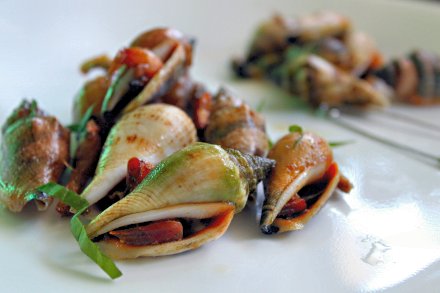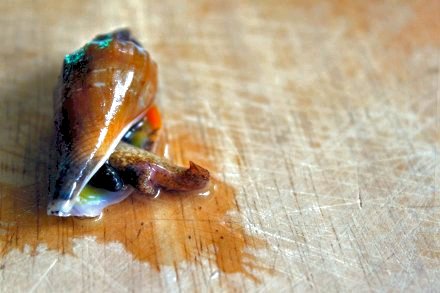
Got twenty? Then you have enough for some fresh shellfish. Known locally as anínikád, these marine snails are sold by the bucketful (a “Caltex” it’s called, after the container), although if you’re the type who likes to wade into the tidal zone then you can pick as many as you like at no cost at all.
Snails — and gastropods, in general — are the most numerous of the mollusc species. (Molluscs, in turn, comprise “about 23% of all named marine organisms,” says Wikipedia.) As invertebrates, they are close relatives of the cephalopods (squid, octopus), bivalves (clam, oyster, mussel, scallop), and crustaceans (shrimp, crab, lobster) — the cheap relatives, you could say. Consider how no one bothers to haggle with the snail vendor. You can, of course, but at 10 to 15 pesos a Caltex, what would be the point? To haggle it down to nothing?
Nutrition-wise, snail is a rich source of protein and other vitamins and minerals. It’s not for everyone, to be sure: certain people are allergic to shellfish, or it may be proscribed by their religion (some branches of Islam, for example, don’t consider it halal), or simply by their physician (gout, anyone?). But if you’re looking to end world hunger, you could do worse than encourage people to eat snail and its ilk. Fresh. Abundant. Nutritious. Cheap. The only problem is that it doesn’t look or sound sexy — not unless you’re French, and they find women with armpit hair sexy.
That’s not a digression; I’m just saying that eating mucus-coated bottom-feeders may take some getting used to for the uninitiated. Presenting anínikád in the raw:

And there you have it. If you ask me, butchered livestock don’t look half as good, and certainly nowhere near as fresh (or alive). Having grown up eating snail, I see that specimen and immediately think of coconut milk and lots of ginger. That, however, would raise the cost of the dish by well over 100%, a coconut costing more than a Caltex of snails these days (go figure).
So here we have a simpler if no less satisfying dish. To make, throw the snails (thoroughly cleaned/brushed) into a pot of cold seawater (or salted water, if you don’t have). Let the water slowly come to a boil and wait until the snails emerge before draining the liquid. In a hot skillet, sauté some sliced ginger until browned, then add two cloves of chopped garlic. Stir for a bit before adding the snails. Let cook for 3 to 5 minutes or until all of the water has evaporated. Serve with rice and some safety pins (for poking the meat from the shell).
I don’t know about you, but I like to suck every last bit of flavor from shellfish, and I mean that literally. You haven’t tasted the essence of sea and snail until you’ve popped a shell into your mouth and sucked it clean and good — and I don’t care how that sounds, or even looks. You’ll just have to trust me (and the French) on this one. You’ve still got the twenty. Would you rather have a Cornetto?
This post has no comments.
Post a Comment